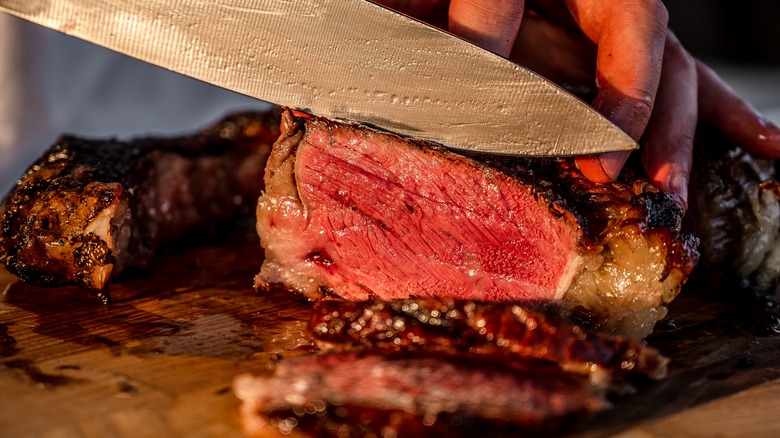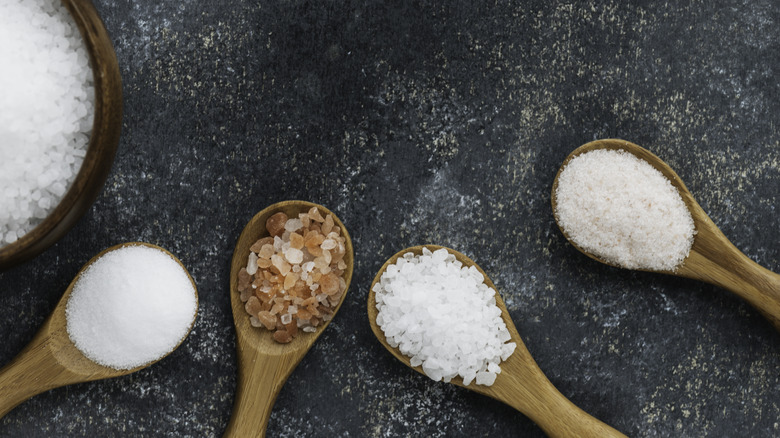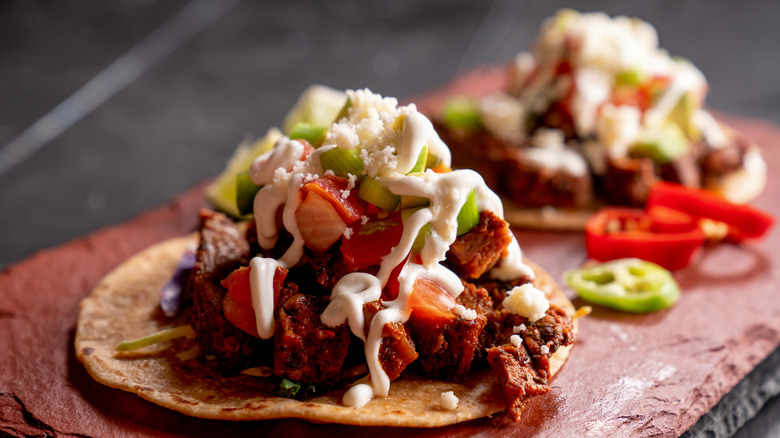How To Get The Most Flavor Out Of Your Steak, According To An Expert
Some home cooks have a problem with simplicity: They truly believe that the absolute best way to cook a perfectly good steak involves either liberally coating it in a dry rub or bathing it for hours in a marinade. To get the final word on the matter, Daily Meal spoke with Sean Thompson, the executive chef of Porter House Bar and Grill, which we consider one of the 14 best steakhouses in New York City. Thompson had only two words of advice when asked about the best seasoning method for steak: "Salt and salt," he replied.
"Keep it simple," he explained. "Don't overthink it. Pepper tends to burn; salt brings out the natural flavor of beef." As you might imagine for the executive chef of one of New York's most renowned steakhouses, he's right: Salt is more than a condiment; it's almost magical in what it can do for a steak's flavor as well as its texture. Also, unlike cracked black pepper, salt won't scorch and turn acrid when the steak is exposed to a high-heat sear.
What is the greatest seasoning in the world and why is it salt?
You should be salting all sorts of meats beyond the Thanksgiving turkey — including brining smaller cuts like pork chops (but not for too long). Brines are known to make meat more flavorful and juicy, and guess what? The active ingredient in any brine isn't the water, sugar, or aromatic herbs and vegetables: It's the salt. In fact, salt will do its thing regardless of whether it's dissolved in a liquid brine. The reason is osmosis.
Let's say you've got a gorgeous ribeye coming up to room temperature and coated in kosher salt (a process known as dry brining). The seasoning, currently sitting on the exterior, will ultimately find its way inside. It does this by pulling moisture out of the meat, which in turn dissolves the salt (hence the not-scorching part), allowing for reabsorption. The sodium will denature (or unwind) the tight strands of proteins, trapping more moisture — i.e. juiciness. The delicious part is that our tongues are made to taste salt; it enhances the natural flavor of any food while reducing off-tastes like bitterness. The more salt that's in the interior of your steak, the more delicious it will be. Luckily, this process only takes about 15 minutes for a wet brine or 40 minutes for dry.
By contrast, pepper is best left for after your steak is cooked. "Feel free to finish with a little cracked pepper if you insist," Sean Thompson notes.
Steaks, dry rubs, and notable exceptions
Having gotten Chef Sean Thompson's preference for dry-brining steak, we wondered how he felt about marinades. "For beef, I almost always prefer dry," he straightforwardly responded. "With a marinade, it tends to leave beef watery which can result in a sear that doesn't give you that wonderful crust you're looking for. There's always exceptions, like carne asada." When the chef says dry, he means dry: In addition to black pepper, dried herbs will also burn when you're searing steak. And searing is the name of the game — any lingering moisture on the surface of the beef will cause it to steam, not sear, because the cooking temperature will be held to water's boiling point of 212 degrees Fahrenheit until it evaporates.
As for Thompson's dry-rule exception of carne asada, he's not wrong. In this Mexican delicacy, cuts like skirt steak are marinated for several hours in a marinade that might include citrus juice, olive oil, garlic, chiles, and spices (including salt, natch), then flash-grilled over a bed of very hot charcoals. With this preparation, though, you're really going for a char instead of a sear — once the lingering surface moisture in the marinade quickly steams off, you'll want to give it a slightly blackened, crispy exterior while keeping the interior just cooked through.


